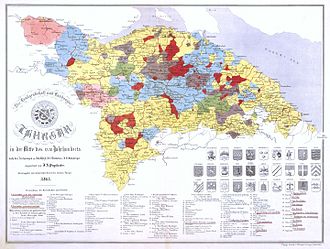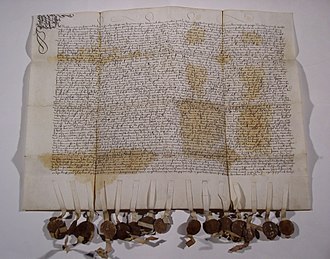Jurisdiction in Thurgau
The judiciary was an orderly association of secular and spiritual owners of lower judicial authorities (Vogteien) in the Landgraviate of Thurgau and formed a corporation at the latest since the 16th century, which institutionalized itself in the annual judges' day as a kind of local authority until the end of the Ancien Régime in 1798 sought to protect lordly interests and rights on the one hand towards the federal governor in Thurgau and on the other hand towards the landscape (communities, quarters).
Creation and training
The confederates ( Zurich , Lucerne , Uri , Schwyz , Unterwalden , Zug and Glarus ) conquered the Landgraviate of Thurgau in 1460, acquired the Thurgau regional court together with Bern , Freiburg and Solothurn in 1499 and thus claimed the concentration of all rulership rights in their common rule in Thurgau. This was an important moment for the constitution of the judiciary, as the secular and spiritual judges defended their previous rights, old freedoms and privileges and defended themselves in corpore . As a result, the court lords, as holders of lower jurisdiction, and the confederates, as sovereigns, delimited their legal powers in the court lords contract. While the abbot of St. Gallen in the treaties of 1501/1512 and the bishop of Konstanz with the treaty of 1509 reserved certain special privileges vis-à-vis the confederates, the other bailiwick owners had to subordinate their rule to the federal blood court, military and Recognize sovereignty in the court lords contract of July 20, 1509. These power contracts formed the basis for the judicial rights. This regulation did not undergo any radical change until 1798.
The judges' day
Since 1581, the court rulers met annually for the so-called court rulers' days (until 1542 in Frauenfeld and 1544–1798 in Weinfelden in the Gasthaus zum Trauben). In the 16./17. In the 19th century, the corporate nature of the court rulership was constitutionally established with committees, a joint fund, a seven-member board, individual functionaries (governor, lieutenant, ensign and court secretary) and deputations. The main purpose of the judges' day was to preserve the privileges and freedoms of the class vis-à-vis the federal governor and the Thurgau subjects. In addition, the road construction and the organization of the border guard (from 1620 in cooperation with the Thurgau military quarters) belonged to the tasks of the court rulers.
In numerous submissions (memorials, complaints, etc.) to the governor and the Federal Diet , the judiciary sought to gain influence. If he was unsuccessful with the Diet, the judiciary sent deputations to the ruling estates to acquire local votes in order to reverse the decision of the Diet. In 1626 the court lords managed to thwart the decision to introduce a Thurgau district administrator . With the neighborhood organization, he led decades of disputes over the amount of taxes that the court had to pay to the border guards. A first comparison in 1643 always brought correspondence and right-handers. Only the mandate of December 4, 1691 from Bailiff Johann Ulrich Püntener von Braunberg with a new settlement brought some reassurance. According to this, the court of justice had to relieve the quarters with a quarter of the expenses for the military border guard.
From the 16th century to 1798, the jurisdiction of the judiciary did not appear as a unified corporation supported by the same interests, as tensions arose between the secular and spiritual judges as well as between the denominations . The taxes (investments) also gave rise to constant disputes. Since around 1620 there were three main bodies in the Landgraviate of Thurgau with the court lordship, the district organization and the federal governor, which worked sometimes with one another, sometimes against one another in different groups. The personal overlaps also show the dependent and peculiar position of the court lords. As a member of the Zurich estate , the Obervogt von Weinfelden was a representative of the sovereignty; but he also belonged to the court lordship and, as district captain of the Weinfelden district, held a leading position in the Thurgau district organization.
The downfall
Since the 17th century, the court had gradually lost its importance at the expense of the landscape, not least with the loss of its military function to the district organization. Although he was able to assert his privileges and rights vis-à-vis the federal bailiff in Frauenfeld as well as the countryside, the persistent and conservative stance of the court lordship in the rulership structure of the Landgraviate of Thurgau also made it increasingly rigid. After 1798, during the reaction during the Second Coalition War, from June to September 1799, the court rulership was reassumed for a short time. In 1804 he was finally liquidated.
The valuable archives of the court rulers - it was long considered missing - remained with the last governor Karl Franz Ignaz von Würz à Rudenz, Obervogt zu Arbon , passed on to his descendants and finally came into the possession of the von Streng family. This has been on permanent loan in the Thurgau State Archives since 1999 .
The order of precedence on the judge's day
(Late 18th century)
Officials of the judiciary
(18th century)
Provincial governors
- 1696–1703 Baron Caspar Conrad von Beroldingen , court lord of Gündelhart
- 1703–1704 Baron Landschreiber Sebastian Anton von Reding von Biberegg , court lord of Klingenzell and Emmishofen
- 1704–1719 Baron Gall Antoni von Thurn-Valsassina , court lord of Berg and Obervogt of Romanshorn
- 1723–1742 Junker Daniel Hermann Zollikofer , court lord of Castel and Hard
- 1742–1760 Baron Landschreiber Ludwig Wolfgang von Reding von Biberegg , court lord of Klingenzell, Emmishofen and Wittenwil
- 1761–1763 Junker Gerold Heinrich von Muralt , court lord of Öttlishausen and Zihlschlacht
- 1763–1798 Baron Karl Franz Ignaz von Wirz à Rudenz , Herr zu Tägerschen and Obervogt zu Arbon
Country lieutenants
- 1705–1723 Junker Wolf Dietrich von Breitenlandenberg zu Salenstein
- 1723–1742 Baron Remigius von Rüpplin zu Kefikon , Obervogt zu Frauenfeld
- 1742–1759 Junker Johannes Zollikofer from Wolfsberg
- 1759–1760 Junker Gerold Heinrich von Muralt , court lord of Öettlishausen and Zihlschlacht
- 1761–1763 Junker Karl Franz Ignaz von Wirz à Rudenz , from 1762 court lord of Tägerschen and Obervogt of Frauenfeld
- 1763–1789 Junker Hartmann Friedrich von Breitenlandenberg from Wolfsberg
- 1789–1798 Junker Franz von Muralt , court lord of Öttlishausen
State ensigns
- 1700–1705 Junker Wolf Dietrich von Breitenlandenberg zu Salenstein
- 1706–1757 Baron Wolfgang Friedrich von Reding von Biberegg at the castle, court lord of Dettighofen
- 1759–1763 Junker Hartmann Friedrich von Breitenlandenberg from Wolfsberg
- 1765–1775 Baron Felix Thaddäus von Rüpplin zu Kefikon , court lord of Wittenwil
- 1775–1789 Junker Franz von Muralt , court lord of Öttlishausen
- 1789–1794 Junker Lorenz Mayer von Baldegg , lord of Mammertshofen Castle
- 1794–1798 Matthias Schulthess , court lord of Wittenwil
Court secretaries
- 1687–1710 Wolfgang Schlatter , from Bischofszell
- 1710–1760 Joseph Antoni Harder , von Tägerschen
- 1760–1761 Johann Conrad Locher , von Frauenfeld (ad interim)
- 1761–1794 Johann Georg Anderwert , von Emmishofen , Oberamtmann von Münsterlingen
- 1794–1798 Joseph Anderwert , von Emmishofen , Oberamtmann von Münsterlingen
- 1798–1804 Adrian Anderwert , von Emmishofen , cloister master of Münsterlingen (provisional)
Jurisdiction archive
- StATG 0'7 (State Archives of the Canton of Thurgau, Sign. 0'7) Jurisdiction
- StATG 0'70'0–29 1504–1804 documents and files (indexed up to document level)
- StATG 0'71'0 1707–1759 General patents (developed up to document level)
literature
- Bruno Giger: court lords, court lords, court lords in Thurgau from the end of the late Middle Ages to the early modern period (= Thurgauian contributions to patriotic history. Vol. 130). Historical Association of the Canton of Thurgau, Frauenfeld 1993, ISBN 3-9520596-0-9 , pp. 5–216 (also: Zurich, University, dissertation, 1993).
- Hermann Lei: The Thurgau court lord in the 18th century. An example of corporate freedom in a common rule of the old Confederation (= Thurgauian contributions to patriotic history. Vol. 99, 1963, ZDB -ID 505614-7 ). Pp. 3-177.
- André Salathé: Visit to the Museum of the Late Middle Ages. On the return of the small but weighty archive of the Thurgau jurisdiction to the canton. In: Thurgauer Zeitung , September 3, 1999.
- André Salathé: inventory overview. State Archives of the Canton of Thurgau (= Finding aid. No. 1). State Archives of the Canton of Thurgau, Frauenfeld 2005, p. 25, p. 28.
See also
Web links
- Verena Rothenbühler: Jurisdiction. In: Historical Lexicon of Switzerland .


